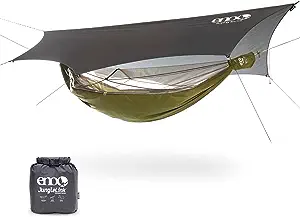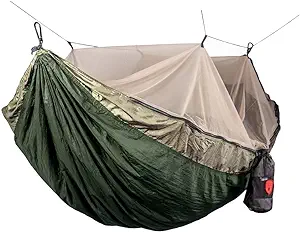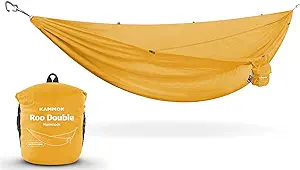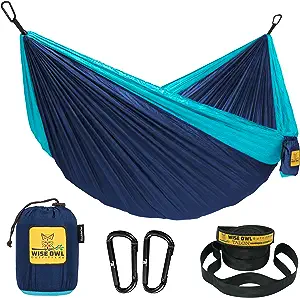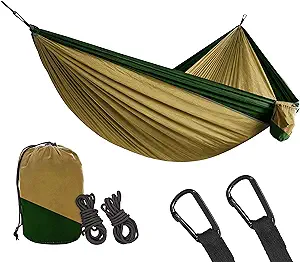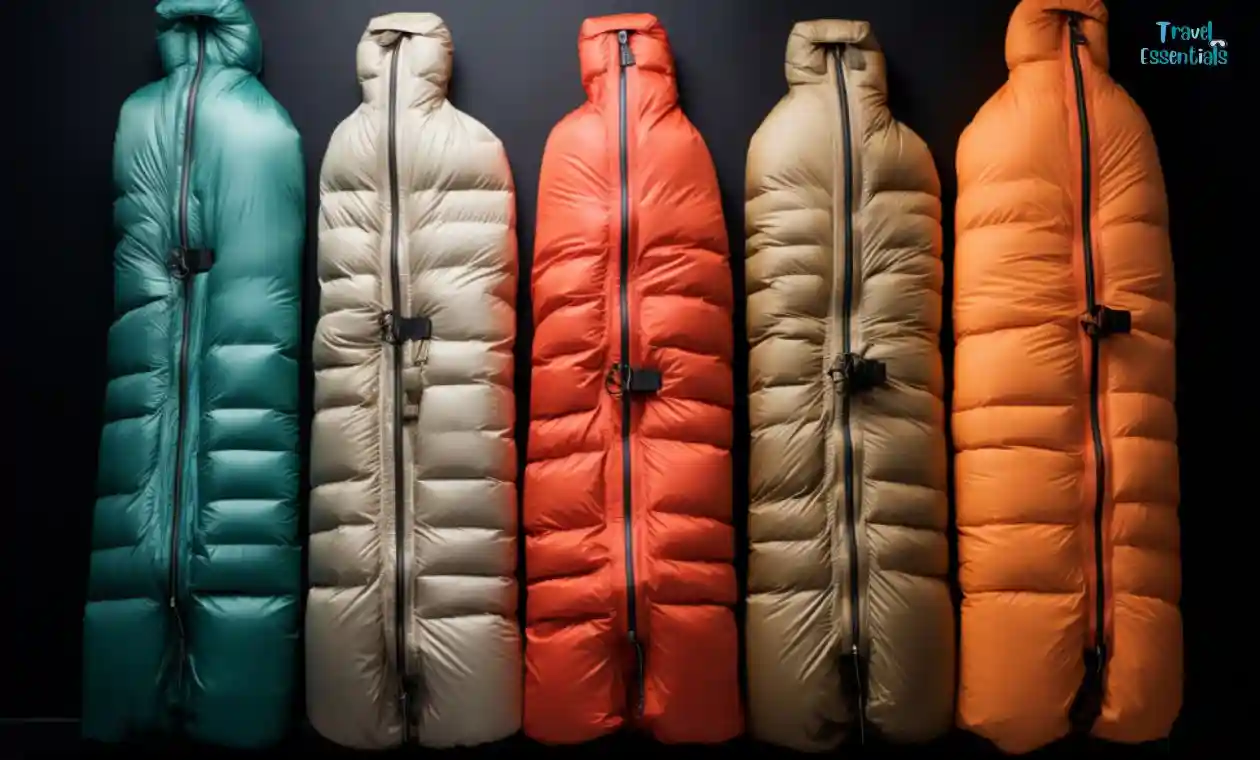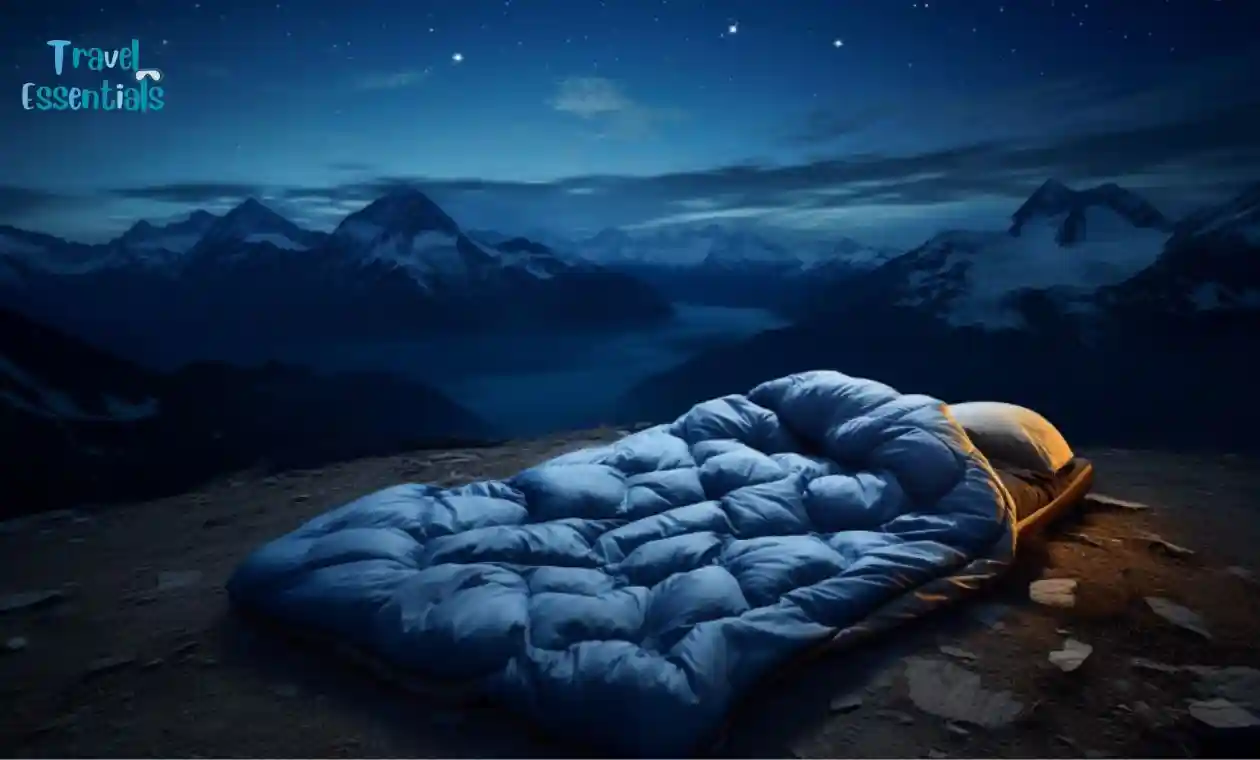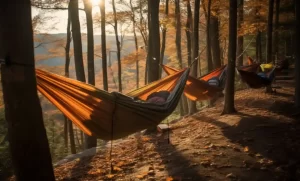
Camping enthusiasts often seek the purest connection with nature, and there’s no better way to forge that connection than by sleeping under the open sky. Camping under the stars has a timeless allure, invoking a sense of adventure, tranquility, and oneness with the great outdoors.
The stars above serve as your celestial canopy, and the fresh, unpolluted air becomes your sleep aid. While traditional tent camping has been the go-to choice for many, an alternative method has been steadily gaining traction and capturing the hearts of outdoor enthusiasts – camping hammocks.
Camping hammocks are lightweight, versatile, and offer a unique way to experience the great outdoors. These hammocks provide a comfortable and suspended sleeping platform, giving you the sensation of floating among the trees. Their ease of setup, minimal environmental impact, and enhanced comfort have made them a favored choice for backpackers, hikers, and campers who want a more immersive outdoor experience.
This article delves into the world of camping hammocks, exploring their benefits, various types, essential accessories, setup tips, and the brands and models to consider. We’ll also discuss safety considerations and the Leave No Trace principles that all responsible campers should uphold.
Whether you’re a seasoned adventurer or a novice camper, this guide will help you make the most of your camping experience under the open sky with camping hammocks. So, let’s embark on a journey of discovery and restful nights among the stars.
The Benefits of Camping Hammocks
Camping hammocks offer a range of benefits that set them apart from traditional tents, making them an appealing choice for outdoor enthusiasts. Here, we’ll delve into the advantages of using camping hammocks:
- Comfort: Camping hammocks provide an elevated sleeping experience that can be incredibly comfortable. Instead of sleeping on uneven or rocky ground, you’ll be suspended in a gently swaying hammock, which can lead to a more restful night’s sleep. Many campers find the sensation of being cradled by a hammock conducive to relaxation and deep slumber.
- Versatility: Camping hammocks are incredibly versatile and adaptable. They can be set up in various environments, whether you’re deep in the backcountry, at a beachside campsite, or simply in your backyard. Their versatility makes them a go-to choice for backpackers, hikers, and travelers seeking a portable sleeping solution.
- Reduced Environmental Impact: Using a camping hammock can have a reduced environmental impact compared to traditional tent camping. Hammocks don’t require stakes or tent footprints, which can disturb the natural environment. By using suspension straps and anchor points that won’t harm trees or vegetation, campers can minimize their impact on the surroundings, following Leave No Trace principles.
- Weight and Size: Camping hammocks are typically lighter and more compact than tents, making them an excellent choice for those looking to cut down on pack weight and bulk. This is especially beneficial for backpackers and hikers who need to carry their gear for long distances.
- Improved Air Circulation: Hammocks provide excellent ventilation and airflow. This can be a significant advantage in warm or humid conditions where tents might become stuffy. Improved airflow can help regulate temperature and reduce condensation, enhancing overall comfort.
- Quick Setup: Setting up a camping hammock is usually quicker and more straightforward than pitching a tent. With practice, you can become proficient at hammock setup, allowing you to spend less time on camp chores and more time enjoying your surroundings.
- Unique Camping Experience: Hammock camping offers a unique and immersive outdoor experience. You’ll be sleeping off the ground, potentially among the trees, allowing you to connect more intimately with nature. The sounds, sights, and sensations of the great outdoors become an integral part of your camping experience.
Camping hammocks provide a comfortable and eco-friendly alternative to traditional tents. Their versatility, reduced environmental impact, and unique camping experience make them a compelling choice for those seeking a closer connection with nature while enjoying a good night’s rest.
Types of Camping Hammocks
Camping hammocks come in various types, each designed to cater to different needs and environments. Let’s explore the different types of camping hammocks and their specific uses and benefits:
Single vs. Double Hammocks
- Single Hammocks: These are designed for solo campers or those who prefer to have their hammock to themselves. They are typically more compact and lightweight, making them ideal for backpacking and solo adventures.
- Double Hammocks: These are wider and more spacious, designed to accommodate two people comfortably. They’re perfect for couples or individuals who want extra space or room to spread out.
Hammocks with Mosquito Nets
- With Mosquito Nets: Camping in bug-prone areas? Hammocks with built-in mosquito nets are your best friends. They offer protection from pesky insects and are particularly valuable for jungle or tropical environments.
- Without Mosquito Nets: If you’re camping in bug-free locations, a hammock without a mosquito net provides unobstructed views and better ventilation.
Ultralight and Minimalist Hammocks
- Ultralight Hammocks: These hammocks are designed for minimalist backpackers. They’re incredibly lightweight and compact, making them a great choice for thru-hikers and adventurers looking to cut down on pack weight.
- Minimalist Hammocks: These hammocks have a simplified design, with fewer attachments and features. They’re perfect for campers who want a straightforward setup without extra frills.
Bridge and Spreader Bar Hammocks
- Bridge Hammocks: These hammocks have a unique design with a flat sleeping surface. They offer excellent back support and are a good choice for those who find traditional hammocks uncomfortable for extended periods.
- Spreader Bar Hammocks: These have spreader bars at each end to keep the hammock flat and open. They are ideal for backyard relaxation and lounging.
Expedition and Jungle Hammocks
- Expedition Hammocks: Designed for challenging conditions, expedition hammocks often feature heavy-duty materials and are built for durability. They are suitable for rugged outdoor adventures.
- Jungle Hammocks: These hammocks are equipped with built-in tarps or canopies to provide protection from rain and harsh sun, making them perfect for tropical and rainy environments.
Camping Hammocks with Rainflies
- Rainfly Hammocks: For campers who need weather protection, some hammocks come with integrated rainflies. These provide shelter from rain and wind, allowing you to camp comfortably in various weather conditions.
Each type of camping hammock offers distinct advantages, ensuring that there’s a perfect hammock for every type of outdoor adventure. By choosing the right hammock, campers can optimize their outdoor experience for comfort and enjoyment.
Essential Hammock Accessories
To elevate the hammock camping experience, certain essential accessories play a crucial role. Let’s delve into these necessary hammock accessories and understand how they enhance the overall camping experience:
Hammock Straps
Purpose: Hammock straps are vital for attaching your hammock to trees or anchor points. They distribute weight evenly, reducing the impact on trees and making setup easier.
Benefits: They protect the trees and surrounding environment, minimize damage to the hammock, and offer flexibility in choosing your hammock’s height and tension.
Carabiners
Purpose: Carabiners are used to secure the hammock to the straps. They serve as attachment points and are crucial for a safe and sturdy setup.
Benefits: Carabiners provide a reliable connection, are easy to use, and allow for quick adjustments. They are essential for ensuring your hammock stays securely suspended.
Rainfly or Tarp
Purpose: A rainfly or tarp is crucial for protecting you and your hammock from rain, sun, or harsh weather conditions.
Benefits: It provides shelter, keeping you dry during rainy spells and offering shade during hot, sunny days. This accessory enhances your comfort and safety in various weather conditions.
Bug Net or Mosquito Net
Purpose: Bug nets or mosquito nets are designed to keep pesky insects at bay, allowing you to sleep peacefully without the nuisance of bugs.
Benefits: They protect you from insect bites, ensuring a good night’s sleep. This accessory is invaluable, especially when camping in areas with a high bug population.
Underquilt and Top Quilt
Purpose: Underquilts and top quilts are insulation layers that provide warmth and comfort, replacing traditional sleeping bags.
Benefits: They keep you warm by preventing the cold air from beneath and above your hammock. They’re ideal for extending your camping season into colder months.
Ridgeline Organizer
Purpose: A ridgeline organizer is a storage solution that hangs just above you. It provides a convenient place to keep essential items like a flashlight, water bottle, or reading material.
Benefits: It helps you keep your essentials within easy reach, eliminating the need to climb in and out of your hammock to grab items.
Gear Loft
Purpose: A gear loft is an overhead storage system that attaches to your ridgeline. It’s perfect for stashing gear, clothes, or personal items.
Benefits: It keeps your gear organized and off the ground, ensuring you have a clutter-free hammock and a more comfortable night’s sleep.
Each of these accessories serves a specific purpose, enhancing your hammock camping experience by improving comfort, safety, and convenience. By selecting the right accessories for your adventure, you can enjoy a more enjoyable and stress-free camping trip while suspended under the stars.
Setting Up Your Camping Hammock
Setting up a camping hammock is a straightforward process, but it’s essential to do it correctly for a comfortable and safe camping experience. Follow these step-by-step instructions to set up your camping hammock properly:
Find the Perfect Spot
- Look for two sturdy anchor points, such as trees, posts, or hammock stands, about 10-15 feet apart.
- Ensure the anchor points are strong enough to support your weight and the strain of the hammock.
Hang the Straps
- Wrap the hammock straps around the anchor points.
- Secure the straps by threading the end through the loop, creating a lark’s head knot.
- Adjust the height and tension of the straps by choosing different loops on the straps. For the ideal hang, the hammock should be about 18 inches off the ground when unoccupied.
Attach Carabiners
- Attach the carabiners to the end of the hammock.
- Clip the carabiners to the loops on the hammock straps.
Check the Angle
- Ensure that the hammock hangs with a 30-degree angle from the horizontal. This angle provides a flatter and more comfortable sleeping position.
Test the Hang
- Before getting in, test the hammock’s stability and height. Make sure it’s securely fastened and doesn’t touch the ground.
Optional Accessories
- If you have a rainfly or bug net, set them up according to their instructions.
- Rainflys should be pitched above the hammock to provide protection from rain and sun.
- Bug nets should be attached to your ridgeline or the hammock suspension.
Secure Your Gear
- Use the gear loft and ridgeline organizer to keep essential items within easy reach.
- Place your backpack, shoes, or other gear beneath the hammock to keep them off the ground and dry.
Ensure Safety
- Always enter and exit the hammock carefully to avoid tripping or falling.
- Don’t exceed the hammock’s weight capacity, which is typically mentioned by the manufacturer.
- When camping with a partner in a double hammock, ensure even weight distribution for a balanced hang.
Setting up your camping hammock correctly not only guarantees your safety but also ensures a comfortable and enjoyable camping experience. Whether you’re lounging in the great outdoors or spending the night under the stars, following these steps will help you make the most of your camping hammock.
Tips for a Comfortable Camping Experience
Stay Warm
- Use an underquilt or sleeping pad to insulate your hammock. This helps prevent the cold air from beneath the hammock from cooling you down.
- Use a top quilt or sleeping bag rated for the expected temperature.
Bug Protection
- If you’re camping in an area with insects, consider a hammock with a built-in bug net.
- Use mosquito repellent on exposed skin to ward off bugs.
- Consider a portable, standalone bug net for added protection.
Achieve a Good Night’s Sleep
- Lie diagonally in your hammock to achieve a flatter and more comfortable sleeping position.
- Find the right amount of sag (hammock hang) to minimize back strain.
- Adjust your pillow or use a stuff sack filled with clothes as a makeshift pillow.
- Wear warm, moisture-wicking clothing to stay comfortable through the night.
Efficient Packing
- Use lightweight and compact gear to minimize the weight of your backpack.
- Keep your essentials organized with the help of packing cubes or stuff sacks.
- Multi-purpose gear, such as a headlamp with a red light mode, can help you save space and weight.
Minimize Environmental Impact:
- Follow Leave No Trace principles by packing out all trash and waste.
- Use biodegradable soap for cleaning dishes and yourself.
- Choose established campsites to prevent damage to delicate ecosystems.
Test Your Setup
- Before embarking on a longer camping trip, set up your hammock in your backyard or a nearby park to ensure you’re comfortable and familiar with your gear.
Stay Hydrated and Well-Fed:
- Keep yourself well-hydrated, especially in warm weather.
- Plan your meals ahead and bring lightweight, energy-rich foods suitable for camping.
Hammock Etiquette:
- Avoid overhanging branches or disturbing wildlife when setting up your hammock.
- Respect the environment and other campers by adhering to camping regulations and practicing good camping etiquette.
Be Prepared:
- Always have a basic first aid kit, a multitool, and a way to communicate in case of emergencies.
By following these tips, you’ll not only ensure a comfortable camping experience but also make the most of the unique advantages that hammock camping offers. Enjoy your time outdoors while staying cozy and relaxed in your camping hammock.
Popular Camping Hammock Brands and Models
When it comes to choosing a camping hammock, several well-known brands offer high-quality options to consider. Here are a few popular camping hammock brands and some of their top models, along with descriptions and benefits:
ENO (Eagles Nest Outfitters)
- DoubleNest Hammock: ENO’s DoubleNest is a versatile and comfortable two-person hammock. It’s known for its durability and easy setup, making it a favorite among campers.
- JungleNest Hammock: This model includes a built-in bug net, making it an excellent choice for camping in buggy environments.
Grand Trunk
- Double Parachute Nylon Hammock: Grand Trunk’s Double Parachute Nylon Hammock is known for its affordability and robust construction. It’s an excellent option for budget-conscious campers.
- Mossy Oak Break-Up Country Double Hammock: This camo-patterned hammock is great for hunters and outdoor enthusiasts who want to blend in with their surroundings.
Kammok
- Roo Double Camping Hammock: Kammok’s Roo Double Hammock is known for its durability and comfort. It comes with Python Straps for easy and secure hanging.
Wise Owl Outfitters
- SingleOwl and DoubleOwl Hammocks: Wise Owl Outfitters offers a range of affordable and high-quality hammocks. The SingleOwl and DoubleOwl are popular choices, known for their comfort and reliability.
Bear Butt
- Double Parachute Camping Hammock: Bear Butt’s Double Parachute Hammock is praised for its robust materials and generous size. It’s suitable for taller campers and those who want extra space.
Remember that the best camping hammock for you depends on your specific needs, such as the environment you’ll be camping in, the features you require (e.g., bug net or rainfly), and your budget. Always read reviews and do thorough research to ensure your chosen hammock meets your camping requirements.
Safety and Leave No Trace Principles
Safety Precautions with Camping Hammocks
- Proper Hanging: When setting up your hammock, always ensure it’s anchored securely to sturdy trees or hammock stands. Avoid using dead or damaged trees, as they may not support your weight. Double-check that the suspension system, straps, and carabiners are in good condition and capable of bearing the load.
- Safe Height: The ideal height for your hammock is 18 inches to 2 feet above the ground. This height provides a comfortable seating or sleeping position and reduces the risk of falling out. Avoid hanging your hammock too high, as it can result in more severe falls.
- Weight Limit: Pay attention to the manufacturer’s recommended weight limit for your hammock. Overloading it can lead to tears or damage.
- Inspect Gear: Regularly inspect your hammock, suspension system, and accessories for signs of wear and tear. Replace or repair any damaged components promptly.
- Bug Protection: If your hammock doesn’t have an integrated bug net, consider using a separate one. Insect bites can be uncomfortable and, in some cases, carry diseases.
- Weather Preparedness: Be prepared for sudden weather changes. Carry rain protection, such as a rainfly or tarp, to shield yourself from unexpected rain and wind. Make sure your rainfly is properly staked and tensioned to avoid sagging and water pooling.
- Environmental Impact: Avoid attaching hammocks to fragile or young trees, as this can cause lasting damage. Follow LNT principles to minimize your impact on the environment.
Leave No Trace (LNT) Principles
- Travel and Camp on Durable Surfaces: When camping with a hammock, you have an advantage in adhering to this principle. Hang your hammock between trees to minimize trampling and damage to vegetation. Avoid hanging your hammock in sensitive ecosystems.
- Dispose of Waste Properly: Follow appropriate waste disposal practices, including packing out all trash and adhering to any “pack it in, pack it out” rules.
- Leave What You Find: Do not damage vegetation, disturb wildlife, or alter natural features when setting up your hammock. Use tree-friendly straps to prevent damage to bark.
- Respect Wildlife: Observe animals from a distance and avoid feeding them. Keep a clean campsite to prevent attracting wildlife with food odors.
- Be Considerate of Other Visitors: Keep noise levels down, especially at night. Avoid overcrowding popular hammock camping areas.
By following these safety precautions and LNT principles, you can enjoy your hammock camping experience while preserving the natural beauty of the outdoors for others to enjoy.
Personal Experiences and Testimonials
Personal Experiences and Testimonials
- Personal Camping Adventures: Share your own personal experiences and camping adventures with camping hammocks. Describe the breathtaking locations where you’ve hung your hammock and the unique aspects of your trips, whether it’s the serene mountain views, the gentle sway of the hammock by the beach, or the peaceful night’s sleep you’ve had.
- Testimonials from Fellow Campers: Gather testimonials from fellow campers who have embraced the camping hammock lifestyle. Include their stories of memorable camping trips, the comfort and convenience they’ve enjoyed, and any tips or tricks they’ve discovered along the way. Sharing real-life experiences and endorsements can help readers relate to the benefits of camping with hammocks.
These personal experiences and testimonials not only add authenticity to your content but also provide valuable insights and inspiration for your readers, encouraging them to explore the world of camping hammocks with confidence.
Conclusion
Camping hammocks have revolutionized the outdoor experience, offering a unique and exciting way to connect with nature. As we conclude this journey through the world of camping hammocks, it’s clear that these versatile and comfortable outdoor companions have a lot to offer.
We’ve explored the numerous benefits of camping hammocks, from their superior comfort to the reduced environmental impact. We’ve delved into the different types of hammocks and essential accessories, ensuring you’re well-prepared for your next adventure. You’ve learned how to set up your hammock and maximize your comfort in the great outdoors.
We’ve covered popular brands and models, ensuring that you have a wealth of options to choose from. Safety and Leave No Trace principles are paramount when enjoying the outdoors with your hammock, and we’ve shared valuable insights to keep you safe and environmentally responsible.
As we wrap up, we want to leave you with a sense of wanderlust and adventure. The open sky and swaying hammock await you, offering a profound connection to nature and an unforgettable camping experience. Embrace the freedom and comfort of camping hammocks, and you’ll discover a world of breathtaking vistas, serene nights, and remarkable memories.
So, whether you’re a seasoned outdoor enthusiast or a novice camper, it’s time to consider the allure of camping hammocks for your next journey. Embrace the freedom to explore, sleep under the stars, and create lasting memories in the great outdoors. The world of camping hammocks is yours to discover. Happy camping!
Remember, the possibilities are endless when you’re “Camping Hammocks.”
